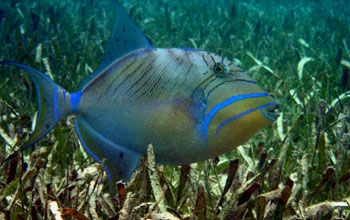Multimedia Gallery
Mangrove Biocomplexity Project (Image 2)
Queen triggerfish (Balistes vetula).
This photo was taken as part of the Mangrove Biocomplexity Project taking place at Twin Cays, an oceanic mangrove ecosystem that lies 12 miles offshore of mainland Belize. Twin Cays is actually two islands that are separated by a shallow channel.
The Mangrove Biocomplexity project is a multidisciplinary effort, funded under the National Science Foundation's Biocomplexity initiative to examine microbial and nutrient controls in mangrove ecosystems. This project is part of the Caribbean Coral Reef Ecosystems Program (CCRE), which is based at the Smithsonian Marine Field Station on Carrie Bow Cay, Belize. Fieldwork is primarily focused on the nearby mangrove system at Twin Cays. (Date of Image: January 2003) [One of 10 related images. See Next Image.]
More about this Image
Mangroves dominate the world's tropical and subtropical coasts, paralleling the geographical distribution of coral reefs. Ecological processes here are influenced by inputs from the land, sea and sky, which result in extreme fluctuations of flooding, salinity, temperature, light and nutrient availability.
Mangrove-associated organisms have specialized physiological and structural adaptations that enable them to thrive in this variable environment. Human-caused enrichment is one of the major global threats to these coastal ecosystems. Long-term experiments at the research facilities of the Smithsonian's Marine Research Network in Belize, Florida, and Panama have shown that nutrients are not uniformly distributed among or even within mangrove forests. Soil fertility can switch from nitrogen to phosphorus limitation across narrow spatial gradients.
The Mangrove Biocomplexity study is exploring the relationships among physical and chemical factors, nutrients, microbes, trees and elemental cycling in clear-water mangrove on offshore islands in Belize.
Dr. Candy Feller, project director, with a team of nine collaborating scientists from institutions across the United States, began fieldwork at the Smithsonian lab on Carrie Bow in July 2000. They are examining the interactions between the environment and organisms to determine how changes in nutrient inputs from natural, agricultural, aquaculture or urban sources might alter the delicate balance among these ecosystem components.
Network analysis will help scientists integrate the findings from each of the disciplines and model the contribution complexity makes to the ability of mangrove ecosystems to survive both natural and anthropogenic disturbances.
The results of the study will help scientists understand how to manage and conserve mangrove ecosystems and will contribute to our understanding of biocomplexity in other ecosystems.
(Note: This image is copyright. Please see "Special Restrictions," below, regarding the use of this image.)
SORRY: THIS IMAGE IS NOT AVAILABLE IN HIGH-RESOLUTION FORMAT
Credit: © Smithsonian Institution
Special Restrictions: This copyright image belonging to the Smithsonian Institution may be used for non-commercial educational purposes, such as teaching, scholarship, research, criticism, commentary and news reporting, without express permission from the Smithsonian, provided proper credit is given and the image is not altered in any manner. Commercial use is strictly prohibited. For any other use, contact the Smithsonian Office of Product Development and Licensing, RightsManager@si.edu.
Images and other media in the National Science Foundation Multimedia Gallery are available for use in print and electronic material by NSF employees, members of the media, university staff, teachers and the general public. All media in the gallery are intended for personal, educational and nonprofit/non-commercial use only.
Images credited to the National Science Foundation, a federal agency, are in the public domain. The images were created by employees of the United States Government as part of their official duties or prepared by contractors as "works for hire" for NSF. You may freely use NSF-credited images and, at your discretion, credit NSF with a "Courtesy: National Science Foundation" notation.
Additional information about general usage can be found in Conditions.
Also Available:
Download the high-resolution JPG version of the image. (599 KB)
Use your mouse to right-click (Mac users may need to Ctrl-click) the link above and choose the option that will save the file or target to your computer.

